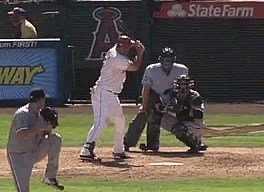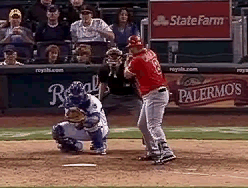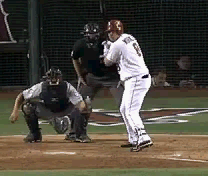Kendrys Morales and Partial Uselessness
As facts about Kendrys Morales go, here are a few of them. On Wednesday, Morales was traded from the Angels to the Mariners in exchange for Jason Vargas. Morales is and has always been a switch-hitter as a professional. Morales began switch-hitting when he was 12 years old, and the right side is his natural side. That is, Morales naturally bats right-handed, and he had to learn how to swing as a lefty. Every switch-hitter starts off with a natural side, but what’s interesting about the Morales case is this:
Career as a lefty: 127 wRC+
Career as a righty: 84 wRC+
Morales has thrived from his unnatural side, and struggled from his natural side. You can pull off an 84 wRC+ if you’re a shortstop or a center fielder or a pitcher, but not so much if you’re a 1B/DH. For his career, as a right-handed hitter, Morales has been unhelpful.
I don’t know what the consensus is on switch-hitters, but most people probably think of them as mirror images. They probably think Player X is more or less Player X no matter which side he’s standing on. Of course we shouldn’t expect that to be true — different sides are stronger than others — and it isn’t true in the case of Morales. The sample size as a righty is limited, perhaps too limited for absolute comfort, but my understanding is that platoon splits for switch-hitters stabilize pretty fast, and Morales’ separation is enormous.
If we dig deeper, we can find more of interest:
| as LHB | wOBA | ISO |
|---|---|---|
| Pull | 0.480 | 0.381 |
| Center | 0.450 | 0.289 |
| Opposite | 0.321 | 0.122 |
| as RHB | wOBA | ISO |
|---|---|---|
| Pull | 0.313 | 0.168 |
| Center | 0.347 | 0.182 |
| Opposite | 0.372 | 0.276 |
Batting left-handed, Morales has been a pretty conventional pull hitter with power up the middle, too. He’s yanked a lot of home runs to right-center field, and a lot of those home runs have been impressive. Batting right-handed, Morales has had the majority of his success up the middle and especially the other way. As a righty, Morales has had his power to right field. There’s no particular Angel Stadium park factor we should be taking into consideration right here. Morales has just done his damage to center and right, regardless of where he’s stood.
If we know that Morales has been worse as a righty, and if we know that he’s hit as a righty to the opposite field, what that suggests is that Morales has been later to get around. We can’t refer to him as a punch hitter or a slap hitter, because those isolated sluggings are substantial. Morales has had power from his natural side. Just not so much pull power. Morales’ strikeout rate has been a little lower from the right side than from the left side. Historically, there’s been no difference in swing rate, and there’s been no significant difference in contact rate. It’s the batted-ball profile that’s different.
Before we move on, I suppose I should show you some dinger .gifs. This is a post topic that cries out for images. We should get an idea of what Morales’ swings actually look like. These are all from 2012.
Morales certainly looks powerful from the right side, just as from the left side. Although, granted, I selected clips of home runs, so, yeah. His stances are open, but Morales holds his hands a little higher as a lefty, and he seems to have a more pronounced step. When you have a guy who generates different results, you expect that there will be differences in swing mechanics. Some are easily observed, and I’m not even good at analyzing this sort of thing. If you are, you might see far, far more.
So we’ve established that Morales has been relatively unsuccessful batting right-handed, despite that being his natural side. Now we wonder: are there any signs of improvement, or is this just what Morales is? I did a lot of Googling, and below I’m going to present a few article excerpts:
“His right-handed swing came alive in the second half of the season. That’s important.”
Finding his stroke from his natural right side — he began switch-hitting at age 12 — enabled Morales to play every day after sitting against most lefties early in the season.
Morales made strides in the second half and worked all winter in Miami — taking batting practice six days a week — to refine his right-handed stroke. He also sought out his former hitting coach in Cuba, Miguel Valdez, who had also defected. Valdez filmed him and then tinkered with his right-handed stance.
[…]
“This guy’s got a great swing from both sides. … There’s not going to be much difference when it’s all said and done, I don’t believe,” manager Mike Scioscia said.
“I’ve been able to see the ball better from that side, reading patterns,” Morales said, having raised his average against lefties to .275 and his slugging percentage to .475. “I made a couple of adjustments with my hands.”
Morales didn’t bat a whole lot against left-handed pitchers in 2012, which makes it look like he was being strictly platooned. He basically was, but there were reasons for that: Morales needed some occasional days off, and the Angels needed to play the right-handed Mark Trumbo. In 2010, before getting hurt, Morales wasn’t platooned, nor was he platooned down the stretch in 2009. It’s unclear at this point just what the Angels wound up thinking about Morales as a switch-hitter.
But, in one of the excerpts above, Scioscia says that Morales really found his right-handed swing in 2009’s second half. I’m dreadfully uncomfortable splitting an already small sample like this, but watch what happens if you split Morales’ career at the 2009 All-Star break:
Through ’09 ASB, as a righty: .224/.242/.336
Since ’09 ASB, as a righty: .269/.315/.472
Now the picture looks a little different. We already said that platoon splits for switch-hitters tend to stabilize quickly. Does that mean they can re-stabilize quickly? Is Morales not as useless as his overall career split?
It’s interesting that, for his career, Morales has pulled the ball 40% of the time batting lefty, but 43% of the time batting righty. We wouldn’t have thought that, based on the power profile included above. But of more interest to me are groundballs. Groundballs should not be a big part of Kendrys Morales’ game, on account of he’s Kendrys Morales, just look at him, I mean come on. He’s an aggressive power hitter. So:
| Split | GB% |
|---|---|
| LHB, 06-08 | 45% |
| LHB, 09-12 | 45% |
| RHB, 06-08 | 60% |
| RHB, 09-12 | 50% |
Nothing doing in the left-handed swing. In the right-handed swing, we see a significant drop in groundball rate, as Morales has done a better job of putting the ball in the air, where it belongs (for him). Last season, Morales actually hit more grounders from the left side than from the right side. Last season, from the right side, Morales slugged .471. The sample is small, but performance is performance, and Morales wasn’t even 100% coming back from injury.
Overall, Kendrys Morales has not been much of a switch-hitter, as he’s been fairly unproductive batting right-handed, which is a big part of any switch-hitter’s job. Given Morales’ career splits, one assumes the Mariners should think about platooning him going forward. Yet there are signs that Morales might have made substantial progress over the years. It’s hard to say anything for sure, given the nature of the sample sizes we’re dealing with, but Morales might not actually be partially useless, as he used to be. His natural side might be catching up, and for a guy a year away from free agency, there are worse career possibilities.
Jeff made Lookout Landing a thing, but he does not still write there about the Mariners. He does write here, sometimes about the Mariners, but usually not.



#6org
Hit a nerve with that one!
Ow. Stop it.